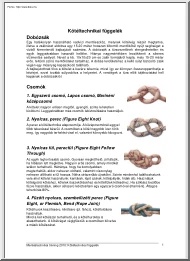Datasheet
Year, pagecount:2017, 6 page(s)
Language:English
Downloads:1
Uploaded:February 21, 2019
Size:731 KB
Institution:
-
Comments:
International Journal of Electronics
Attachment:-
Download in PDF:Please log in!
Comments
No comments yet. You can be the first!Most popular documents in this category
Content extract
using ANSYS Workbench by keeping the angle of attack as a parameter. At lower angle of attack, the Kite stalls as the lift produced is very less At higher angle of attack, the lift is more hence more power is generated. By using ANSYS numerical computing environment, a correlation of the forces with various angle of attacks are analyzed with the practical experiment. This analysis gives the net power that can be harnessed from thewind Index terms Parafoil Kite, Kite Energy, Wind Energy, Energy conversion, ANSYS Environment, Angle of Attack, Energy Simulation. I.INTRODUCTION:Sustainableenergyismostfocusedtopicastheconventionalenergy sourcesarefiniteandaredamagingtheenvironment.Windenergyisproducedbytheirregular heating of the earth’s surface [1]. Due to the convection of air, wind blows on the surface of earth Wind energy is more probable at higher altitude [2]. The power of the wind at a higher altitude can be harnessed by using a parafoilkite [3]. The parafoil or airfoil kite was
experimented in Hmuifang. Hmuifang is one of thefamous tourist spot which is 50km away from capital city Aizawl, Mizoram with an elevation of 1619 meters. This beautiful destination is situated on the parent hill Lushai hills The wind is more strong and consistent in this spot. The lift of the kite was measured and compared with the simulatedresult. The whole numerical and analytical experiment was analyzed in the ANSYSenvironment. ANSYS Fluid Flow Fluent is a powerful tool for analyzing the force and wind velocity of an air foil. The parafoil kite is designed in ANSYS Fluent by using the design modeler inwhich 33 Roystan V Castelino, Suman Jana, and Ramesh Kumar Source: http://www.doksinet International Journal of Electronics, Electrical and Computational System IJEECS ISSN 2348-117X Volume 6, Issue 12 December 2017 the angle of attack is set as a parameter. The Angle of attack is varied and the simulation
resultcanbenoted.Theforcesonthekiteisanalyzedbykeepingthekiteinsidetheenclosure Using the Boolean function, the kite body is subtracted from the enclosure. Using the body transformation, the kite is rotated at an angle which is the angle of attack. The enclosure is a cubeinwhichoneofthefacesisnamedastheinletfromwhichairataparticularvelocityenters and exits the other face which is named as the outlet. The other faces around the enclosure named as the outer walls. The simulation starts from the inlet to theoutlet The lift produced by parafoil kite is transferred to the ground through its strings. The lift producedisintheformofkineticenergywhichthenconvertedintorotatorymotion.Thestring of the kite which is wound on a reel gets unwound which makes the reel rotate and thus this rotation is connected to the shaft of the generator. The main objective of this experiment is to harness high altitude wind energy using a controlled power kite. The wind at higher altitude is stronger and
consistent. This energy can be harnessed using a power kite to increase the efficiency, decrease the cost, reduce the area required, and reduce initial cost and to make it environment friendly. The kite is tethered to the base station through wires Without a tower holding them set up, control kites wipe out 90 percent of the material and 50 for percent of the introduced cost of regular wind turbines. At the same time, the tether allows the kite to access better wind at higher altitudes, which makes it cheaper to install in places where traditional turbines don’t work. This more than doubles the amount of land available for wind energy production. The kite also houses a wireless camera which gives the live footage of the II. OVERVIEW OF THE SYSTEM: surroundings.ThisprojectmainlyfocusesonelectrificationofruralareasItprovideselectrical output as well assecurity. (a) Schematic diagram of wind energy (b) Comparison of wind turbine and kite conversion using parafoil kite energy [4].
Figure1:Schematicdiagramrepresentationwithcomparisonofwindturbinewithkiteenergy. Figure1showstheschematicdiagramrepresentationandcomparisonofwindturbinewith kiteenergy.Figure1(a)showsthebasicschematicdiagramofkiteenergysystemInthisfigure G is the generator which is connected to the thread reel shaft. And also, the kite controller is usedtomaneuverthekitetoobtainmaximumlift.TheKitewillexertforceonitsstringswhich intern rotates the thread reel. The thread reel which is connected to the shaft of the generator convertsthekineticenergyproducedbythekitetotherotatorymotion. The figure 2 shows the kite lift analysis with different angle of attack. The analysis was experimented in Hmuifang village of Aizawl district. 34 Roystan V Castelino, Suman Jana, and Ramesh Kumar Source: http://www.doksinet International Journal of Electronics, Electrical and Computational System IJEECS ISSN 2348-117X Volume 6, Issue 12 December 2017 (a) Kite lift analysis with zero degree an- (b) Kite lift analysis
with 45-degree angle gle of attack of attack Figure 2: Kite lift analysis with different angle of attack in Hmuifang,Aizawl. The figure 2(a) shows lift of the kite with zero-degree angle of attack. Figure 2 (b) shows the lift analysis with 45-degree angle of attack. This parafoil kite used in this experiment has four lines. The top two lines are called as power lines and the bottom two lines are called as breaking lines. The lift power produced by the kite is extracted by the power lines. The kite angle of attack is adjusted by using breaking lines. III. SIMULATION DIAGRAMS: (a) Steps involved in designing parafoil kite in ANSYS Workbench the (b) Modeling of parafoil kite in ANSYS design modeler. Figure 3: The modeling of parafoil kite for simulation of different forces. Thefigure3showsthestepsinvolvedwithinANSYSworkbenchenvironmentandmodelin ANSYSdesignmodeler.Thefigure3(a)showsthedifferentstepssuchasgeometrymodeling,
meshoperation,setup,solutionandresultsforvaryingparameters.Figure3(b)showsthesketch designed in the ANSYS designmodeler. 35 Roystan V Castelino, Suman Jana, and Ramesh Kumar Source: http://www.doksinet International Journal of Electronics, Electrical and Computational System IJEECS ISSN 2348-117X Volume 6, Issue 12 December 2017 (a) The meshing operation of parafoil(b) The boundary condition of the kite. parafoil kite. Figure 4: The modeling of parafoil kite with meshing operation and boundary condition. The figure 4 shows the modeling of parafoil kite with meshing operation and boundary condition.Figure4(a)showsthemeshinginANSYSdesignmodelerwiththesketchdrawnon figure 3(b) in a solid domain with 107290 nodes and 587463 elements. The figure 4(b) shows the boundary condition in 3D model generated from the sketch shown in figure 3(b). Theinlet boundary is assigned as velocity inlet, and the outlet boundary is assigned as pressure outlet. And the remaining boundaries are assigned
aswalls. IV. RESULT AND DISCUSSIONS: In this experiment 100 iterations were performed to get the accurate experiment result and better response of the kite. The input velocity was 10 m/s at the inlet which was measured in Hmuifang village of Aizawl. The animated results were visualized by using ANSYS CFDPOSTenvironment (a) path-line of wind with velocity result. (b) Force vectors on the kite. Figure 5: path-line, wind velocity and force vectors analysis using ANSYSenvironment. The figure 5 shows the path-line, wind velocity and force exerted on the kite by usingANSYSCFD-Postenvironment.Figure5(a)showsthepath-lineoftheappliedwindwiththewind velocity variations around the kite. Figure 5(b) shows the force vectors on the kite with the velocity of wind around thekite. 36 Roystan V Castelino, Suman Jana, and Ramesh Kumar Source: http://www.doksinet International Journal of Electronics, Electrical and Computational System IJEECS ISSN 2348-117X Volume 6, Issue 12 December 2017 Table
1: Force analysis with different angle of attack Angle of attack 0 10 20 30 40 50 60 70 80 90 X-axis -1.2732 0.00901845 -0.654372 -1.5849 0.096858 2.21622 -0.993545 -2.70931 -3.24189 -1.84303 Forces (inN) Y-axis Z-axis 1.77513 -8.99585 76.948 -12.8191 137.483 -28.6439 147.726 -69.2979 166.132 -126.796 149.156 -175.873 107.556 -207.711 53.9798 -219.152 6.20469 -221.702 -34.5345 -211.936 Max Velocity(m/s) 13.40 16.59 18.64 18.31 18.99 21.54 23.38 25.17 24.91 23.76 Table 1 shows the force exerted on the kite in x,y and z axes with maximum velocity variation at trailing edges. (a) Graph of convergence of result with (b) Wind diversion due to kite with 45 deiterations. gree angle of attack. Figure 6: Graph of iterations and wind diversion path-line. The figure 6(a) shows the result convergence graph and figure 6(b) shows the diversion of wind with 45-degree angle of attack. (a) Animated wind path-line. (b) Actual wind path-line after diversion. Figure 7: Animated and actual
path-line of the wind in ANSYS CFD-POSTenvironment. 37 Roystan V Castelino, Suman Jana, and Ramesh Kumar Source: http://www.doksinet International Journal of Electronics, Electrical and Computational System IJEECS ISSN 2348-117X Volume 6, Issue 12 December 2017 The figure 7(a) shows the animated wind path-line and figure 7(b) shows the actual wind path-line after diversion. V. CONCLUSION: Wind energy generation using parafoil kites is a emerging technology as it harnesses the power of high altitude winds [5, 6]. This technology is still in the developing stage with watt and kilo watt range [7], with the help of ANSYS environment the system can be analyzed for betteroutput.Themainaimofthisexperimentwastoproducemoreenergyfromlessresources The data taken for this experiment is practically evaluated by flying the kite in Hmuifang village. The lift of the kite for different angle of attack was taken and analyzed with ANSYS environment with real-time experiment data. As compared to the
traditional wind turbines, windenergygenerationusingparafoilkitereducestheenergyproductioncostssignificantlyas this technology does not involve heavy foundation and heavyblades. ACKNOWLEDGMENT: ThisexperimentwassupportedbyNationalInstituteofTechnologyMizoram,Aizawl,Mizoram, India. Numerical computing environment ANSYS, Version 1600780908, licensed to NationalInstituteofTechnologyMizoramwasusedwithproperauthorization. References [1] Hong Zhang. Kite modeling for higher altitude wind energy Energy and PowerEngineering, 5:481–488,2013 [2] SardarPatelPratikRao.Proposedairbornetechnologytoextracthighaltitudewindenergy using power kites. International conference on computing, communication and energy systems,2016. [3] Antonello Cherubini et al. Airborne wind energy systems: A review of the technologies Renewable and Sustainable Energy Reviews, 51:1461–1476, 2015. [4] D.MeherSrijaandDPSowjanyaWindenergygenerationusingpowerkitesInternational
JournalofTrendinResearchandDevelopment,3(1),2016. [5] Cristina L. Archer and Ken Caldeira Global assessment of high-altitude wind power Energies, 2:307–319, 2009. [6] S. Costello and C Costello Analysis of the maximum efficiency of kite-power systems Journal of renewable and sustainable energy, 2015. [7] L. Fagiano M Canale Kitegen project control as key technology for a quantum leap in wind energy generators. Proceedings of the 2007 American Control Conference, 2007 38 Roystan V Castelino, Suman Jana, and Ramesh Kumar





